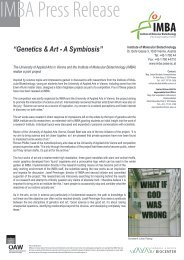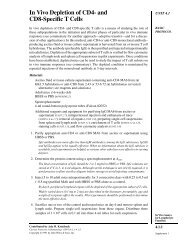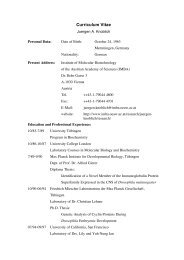"Anesthesia". In: Current Protocols in Immunology - IMBA
"Anesthesia". In: Current Protocols in Immunology - IMBA
"Anesthesia". In: Current Protocols in Immunology - IMBA
Create successful ePaper yourself
Turn your PDF publications into a flip-book with our unique Google optimized e-Paper software.
Anesthesia<br />
Anesthetic agents are used <strong>in</strong> laboratory animals to prevent pa<strong>in</strong> or distress due to an<br />
experimental procedure or for restra<strong>in</strong>t to facilitate a technically difficult procedure.<br />
Agents may be used alone or <strong>in</strong> comb<strong>in</strong>ation to achieve the desired effect. Anesthesia,<br />
analgesia, sedation, and tranquilization are achieved through drug selection and proper<br />
dos<strong>in</strong>g. <strong>In</strong>vestigators us<strong>in</strong>g anesthetic agents should familiarize themselves with their<br />
physiologic effects and the risks <strong>in</strong>volved with their use.<br />
This unit provides three basic protocols: <strong>in</strong>jectable anesthesia for mouse, rat, and hamster;<br />
<strong>in</strong>halant anesthesia us<strong>in</strong>g methoxyflurane for mouse, rat, and hamster; and <strong>in</strong>jectable<br />
anesthesia us<strong>in</strong>g ketam<strong>in</strong>e/xylaz<strong>in</strong>e for rabbit and an alternate protocol for sedation us<strong>in</strong>g<br />
butorphanol/acetylpromaz<strong>in</strong>e <strong>in</strong> the rabbit. The Commentary further describes and compares<br />
these methods of anesthesia for various applications.<br />
INJECTABLE ANESTHESIA FOR MOUSE, RAT, AND HAMSTER<br />
Materials<br />
Anesthetic of choice (Table 1.4.1)<br />
Laboratory balance for weigh<strong>in</strong>g the animal<br />
1- or 3-ml syr<strong>in</strong>ge with 22-G needle<br />
Additional reagents and equipment for handl<strong>in</strong>g and restra<strong>in</strong>t (UNIT 1.3) and<br />
<strong>in</strong>traperitoneal <strong>in</strong>jection (UNIT 1.6)<br />
������������ �����������������������������������������������������<br />
Agent or comb<strong>in</strong>ation Species Dosage (mg/kg) Duration (m<strong>in</strong>)<br />
Pentobarbitala Mouse 40-70 30-60<br />
Rat 30-40 30-60<br />
Hamster 50-90 30-60<br />
Ketam<strong>in</strong>e + xylaz<strong>in</strong>eb Mouse 50-150 15-20<br />
Rat 50-150 15-20<br />
Hamster 50-150 15-20<br />
Tribromoethanolc Mouse 125-160 15-30<br />
Rat 300 15-20<br />
aDilute 1/10 with sterile sal<strong>in</strong>e. This is a controlled substance.<br />
bAdd 1.0 ml of xylaz<strong>in</strong>e (20 mg/ml) to 10 ml ketam<strong>in</strong>e (100 mg/ml) and dose as if mixture were<br />
100 mg/ml. Dilution 1/10 with sterile sal<strong>in</strong>e is recommended for accuracy <strong>in</strong> dos<strong>in</strong>g mice, hamsters,<br />
and young rats. This mixture is based on the use of commercially available sterile stock solutions<br />
of the two anesthetics (available from veter<strong>in</strong>ary supply companies; see Table 1.4.2), not reagentgrade<br />
compounds. Use of nonsterile dry compounds for mak<strong>in</strong>g this mixture is contra<strong>in</strong>dicated<br />
because of the risk of <strong>in</strong>troduc<strong>in</strong>g bacteria or other contam<strong>in</strong>ants dur<strong>in</strong>g the preparation process<br />
and because the dry forms of these drugs do not dissolve readily. It is recommended that the<br />
veter<strong>in</strong>arian member of the <strong>in</strong>stitutional Animal Care and Use Committee be contacted to determ<strong>in</strong>e<br />
how to obta<strong>in</strong> these anesthetics legally for use <strong>in</strong> research. Some <strong>in</strong>stitutions ma<strong>in</strong>ta<strong>in</strong> <strong>in</strong>stitutional<br />
research licenses with the U.S. Drug Enforcement Adm<strong>in</strong>istration for use of these or other<br />
veter<strong>in</strong>ary drugs; at other <strong>in</strong>stitutions, each <strong>in</strong>dividual researcher must have a DEA license.<br />
cMake a 100% (w/v) stock solution by dissolv<strong>in</strong>g 5 g of 2,2,2-tribromoethanol <strong>in</strong> 5 ml 2-methyl-<br />
2-butanol (tert-amyl alcohol). Gentle heat<strong>in</strong>g may be required. A good work<strong>in</strong>g solution is a 1/250<br />
dilution (4 mg/ml) <strong>in</strong> normal sal<strong>in</strong>e; this is stable 4 to 6 months at 4°C <strong>in</strong> a dark bottle.<br />
Contributed by John Donovan and Patricia Brown<br />
<strong>Current</strong> <strong>Protocols</strong> <strong>in</strong> <strong>Immunology</strong> (1998) 1.4.1-1.4.5<br />
Copyright © 1998 by John Wiley & Sons, <strong>In</strong>c.<br />
UNIT 1.4<br />
BASIC<br />
PROTOCOL 1<br />
Care and<br />
Handl<strong>in</strong>g of<br />
Laboratory<br />
Animals<br />
1.4.1<br />
Supplement 27
BASIC<br />
PROTOCOL 2<br />
Anesthesia<br />
1.4.2<br />
������������ ����������������������<br />
Anesthetic Brand name Supplier a<br />
Sodium pentobarbital,<br />
Schedule II general anesthetic,<br />
65 mg/ml<br />
Ketam<strong>in</strong>e hydrochloride<br />
<strong>in</strong>jection USP, 100 mg/ml<br />
Xylaz<strong>in</strong>e hydrochloride,<br />
20 mg/ml<br />
Sodium Pentobarbital <strong>In</strong>jection<br />
Sodium Pentobarbital <strong>In</strong>jection<br />
Ketaject<br />
Ketaset<br />
Ketaved<br />
Vetalar<br />
Anased <strong>In</strong>jection (Dogs)<br />
Gem<strong>in</strong>i SA<br />
Rompun 20 mg/ml <strong>In</strong>jectable<br />
Solvaz<strong>in</strong>e 20 mg/ml<br />
Tranquived <strong>In</strong>jectable (Dogs)<br />
Xyla-ject Can<strong>in</strong>e/Fel<strong>in</strong>e <strong>In</strong>jectable<br />
Xylaz<strong>in</strong>e-20 <strong>In</strong>jection<br />
Tribromoethanol (mixture) 2,2,2-Tribromoethanol and<br />
tert-amyl alcohol<br />
a See APPENDIX 5 for supplier contact <strong>in</strong>formation.<br />
1. Retrieve the animal from its cage, place <strong>in</strong> a tared beaker, and determ<strong>in</strong>e its weight.<br />
2. Calculate appropriate dose of chosen anesthetic.<br />
Us<strong>in</strong>g the guidel<strong>in</strong>es <strong>in</strong> Table 1.4.1, for a 15-g (0.015 kg) mouse, the amount of pentobarbital<br />
to <strong>in</strong>ject would be (0.015 kg × 40 mg/kg) to (0.015 kg × 70 mg/kg), or 0.6 to 1.0 mg.<br />
Similarly, for the same mouse, us<strong>in</strong>g a 100 mg ketam<strong>in</strong>e/20 mg xylaz<strong>in</strong>e mixture, (0.015 kg<br />
× 50 mg/kg) to (0.15 kg × 150 mg/kg ) or 0.75 to 2.25 mg, dosed as if the mixture were 100<br />
mg/ml, 0.0075 ml to 0.0225 ml would be the range to use. (Dilution of the mixture 1:10<br />
with sterile sal<strong>in</strong>e is recommended to ease adm<strong>in</strong>istration of such small volumes.)<br />
If tribromoethanol were the anesthetic of choice, (0.015 kg × 125 mg/kg) to (0.015 kg ×<br />
160 mg/kg), or 1.9 to 2.4 mg, would be the appropriate dose.<br />
Sources of anesthetics are listed <strong>in</strong> Table 1.4.2.<br />
3. Manually restra<strong>in</strong> the animal. <strong>In</strong>ject the selected dose <strong>in</strong>traperitoneally.<br />
4. Return the animal to its cage and monitor for the depth of anesthesia.<br />
INHALANT ANESTHESIA USING METHOXYFLURANE FOR<br />
MOUSE, RAT, AND HAMSTER<br />
Methoxyflurane is a relatively safe anesthetic for rodents, is simple to use, requires no<br />
special equipment, and vaporizes at room temperature to a concentration suitable for<br />
general anesthesia.<br />
Materials<br />
Methoxyflurane<br />
Gauze or cotton sponges<br />
Closed glass conta<strong>in</strong>er with raised floor<br />
Empty syr<strong>in</strong>ge case or 50-ml centrifuge tube (optional)<br />
Butler<br />
J.A. Webster<br />
Phoenix Pharmaceutical<br />
Fort Dodge Labs<br />
Vedco<br />
Fort Dodge Labs<br />
Lloyd Labs<br />
Vetus Animal Health<br />
Bayer<br />
Fort Dodge Labs<br />
Vedco<br />
Phoenix Pharmaceutical<br />
Butler<br />
Commercial chemical<br />
supply houses (e.g.,<br />
Aldrich or Sigma)<br />
CAUTION: All procedures with methoxyflurane should be conducted <strong>in</strong> a fume hood or<br />
safety cab<strong>in</strong>et that cont<strong>in</strong>uously exhausts anesthetic gases away from personnel.<br />
Supplement 27 <strong>Current</strong> <strong>Protocols</strong> <strong>in</strong> <strong>Immunology</strong>
1. Pour methoxyflurane on gauze or cotton sponges and place the soaked material on<br />
the bottom of a closed glass conta<strong>in</strong>er.<br />
2. Place a raised floor over the gauze sponges to permit vaporiz<strong>in</strong>g methoxyflurane to<br />
flow through or around it to fill the conta<strong>in</strong>er.<br />
3. Return the lid to the conta<strong>in</strong>er and let sit 3 to 5 m<strong>in</strong> to allow methoxyflurane to<br />
vaporize.<br />
4. Place the rodent on the raised floor, close the conta<strong>in</strong>er, and observe the animal.<br />
5. Allow the animal to become recumbent and reach slow and regular breath<strong>in</strong>g.<br />
6. Remove the animal from the conta<strong>in</strong>er to perform the appropriate procedure.<br />
If longer periods of anesthetization are needed, fabricate a nose cone from an empty<br />
discarded syr<strong>in</strong>ge case or 50-ml disposable centrifuge tube to ma<strong>in</strong>ta<strong>in</strong> anesthesia. Place<br />
the methoxyflurane-soaked gauze or cotton sponge <strong>in</strong> the closed end of the syr<strong>in</strong>ge case or<br />
tube. Place the open end over the nose of the animal (Fig. 1.4.1). Remove or replace nose<br />
cone as necessary to ma<strong>in</strong>ta<strong>in</strong> adequate anesthesia.<br />
INJECTABLE ANESTHESIA USING KETAMINE/XYLAZINE<br />
FOR THE RABBIT<br />
Materials<br />
20 mg/ml xylaz<strong>in</strong>e (see Table 1.4.2 for sources)<br />
100 mg/ml ketam<strong>in</strong>e⋅HCl (see Table 1.4.2 for sources)<br />
Sterile sal<strong>in</strong>e or phosphate-buffered sal<strong>in</strong>e (PBS; APPENDIX 2)<br />
5-ml syr<strong>in</strong>ge with 22- to 25-G needle<br />
Warm water recirculat<strong>in</strong>g blanket (optional)<br />
1. Determ<strong>in</strong>e the weight of the rabbit <strong>in</strong> kilograms.<br />
2. Draw up 1 ml xylaz<strong>in</strong>e <strong>in</strong>to a 5-ml syr<strong>in</strong>ge with a 22- to 25-G needle.<br />
3. Draw up 2 ml ketam<strong>in</strong>e⋅HCl <strong>in</strong>to the same syr<strong>in</strong>ge.<br />
4. Draw up 1 ml sterile sal<strong>in</strong>e or PBS <strong>in</strong>to the same syr<strong>in</strong>ge.<br />
5. <strong>In</strong>vert syr<strong>in</strong>ge several times to mix the solutions.<br />
6. Adm<strong>in</strong>ister mixture <strong>in</strong>tramuscularly (UNIT 1.6) at a dose of 1 ml/kg (equivalent to 50<br />
mg/kg ketam<strong>in</strong>e and 5 mg/kg xylaz<strong>in</strong>e).<br />
The length of anesthesia will vary from 20 to 75 m<strong>in</strong>. The ketam<strong>in</strong>e/xylaz<strong>in</strong>e comb<strong>in</strong>ation<br />
provides analgesia with muscle relaxation. Hypothermia can be a problem and use of a<br />
warm water recirculat<strong>in</strong>g blanket to ma<strong>in</strong>ta<strong>in</strong> body temperature is recommended.<br />
metophane-soaked gauze<br />
������������� ������������������������������������������������������<br />
BASIC<br />
PROTOCOL 3<br />
Care and<br />
Handl<strong>in</strong>g of<br />
Laboratory<br />
Animals<br />
1.4.3<br />
<strong>Current</strong> <strong>Protocols</strong> <strong>in</strong> <strong>Immunology</strong> Supplement 27
ALTERNATE<br />
PROTOCOL<br />
Anesthesia<br />
1.4.4<br />
INJECTABLE SEDATION USING BUTORPHANOL/<br />
ACETYLPROMAZINE FOR THE RABBIT<br />
This mixture provides good vasodilation and sedation with analgesia to allow for blood<br />
collection from the ear blood vessels without additional physical restra<strong>in</strong>t of the animal.<br />
It should not be used for more <strong>in</strong>vasive procedures such as cardiac puncture.<br />
Materials<br />
10 mg/ml butorphanol<br />
10 mg/ml acetylpromaz<strong>in</strong>e<br />
1- or 3-ml syr<strong>in</strong>ge with 22- to 25-G needle<br />
1. Determ<strong>in</strong>e the weight of the rabbit <strong>in</strong> kilograms.<br />
2. Draw up 0.5 ml butorphanol <strong>in</strong>to a 1- or 3-ml syr<strong>in</strong>ge with 22- to 25-G needle.<br />
3. Draw up 0.5 ml acetylpromaz<strong>in</strong>e <strong>in</strong>to the same syr<strong>in</strong>ge.<br />
4. <strong>In</strong>vert syr<strong>in</strong>ge several times to mix the solutions.<br />
5. Adm<strong>in</strong>ister mixture subcutaneously or <strong>in</strong>tramuscularly (UNIT 1.6) at a dose of 0.2 ml/kg<br />
(equivalent to 1 mg/kg each butorphanol and acetylpromaz<strong>in</strong>e).<br />
COMMENTARY<br />
Background <strong>In</strong>formation<br />
The <strong>in</strong>tensity and duration of an animal’s<br />
response to anesthetic agents is affected by<br />
species, age, genetic background, health or nutritional<br />
status, environmental conditions, and<br />
route of adm<strong>in</strong>istration.<br />
The route of adm<strong>in</strong>istration is largely determ<strong>in</strong>ed<br />
by the formulation of the agent and the<br />
recommendations found on the package <strong>in</strong>sert.<br />
If the formulation allows for multiple routes of<br />
adm<strong>in</strong>istration, the choice is generally based on<br />
the species and desired duration of effect.<br />
The most commonly used route <strong>in</strong> rodent<br />
species is <strong>in</strong>traperitoneal <strong>in</strong>jection because it is<br />
technically simple and results <strong>in</strong> generally safe<br />
and uniform absorption with m<strong>in</strong>imal and predictable<br />
periods of <strong>in</strong>duction and recovery. <strong>In</strong><br />
rodents, the <strong>in</strong>tramuscular route is difficult to<br />
achieve due to the small muscle mass available,<br />
and frequently results <strong>in</strong> unpredictable <strong>in</strong>duction<br />
times, duration periods, and <strong>in</strong>tensity of<br />
effect. The <strong>in</strong>travenous route requires technical<br />
expertise and skill, but has very rapid <strong>in</strong>duction<br />
and recovery phases. However, dosages must<br />
be carefully calculated to ensure adequate anesthesia<br />
without overdose.<br />
Subcutaneous <strong>in</strong>jection of anesthesia, while<br />
very safe, results <strong>in</strong> nonuniform or poor absorption<br />
and quite unpredictable levels of anesthesia.<br />
Because of the small size of rodent species,<br />
most <strong>in</strong>jectable agents should be diluted 5- to<br />
10-fold to enable accurate dos<strong>in</strong>g.<br />
Various <strong>in</strong>halant anesthetics are available for<br />
animals but most are unsuitable for rodents. The<br />
most commonly used agents <strong>in</strong>clude methoxyflurane,<br />
ether, and isoflurane. As noted <strong>in</strong> Basic<br />
Protocol 2, methoxyflurane is generally the<br />
safest and most convenient for use with rodents.<br />
Ether and isoflurane are not recommended for<br />
general use <strong>in</strong> rodents. Ether is both flammable<br />
and explosive. Safe handl<strong>in</strong>g and storage are a<br />
constant concern. Additionally, ether is highly<br />
irritat<strong>in</strong>g to the respiratory tract and excess<br />
respiratory tract secretions can be troublesome<br />
for the animal dur<strong>in</strong>g its use. Physicochemical<br />
characteristics of isoflurane make it difficult to<br />
adm<strong>in</strong>ister. Because isoflurane easily reaches<br />
lethal concentrations at room temperature, a<br />
sophisticated and calibrated vaporizer is<br />
needed for its use.<br />
Because of their larger size, rabbits can be<br />
effectively anesthetized with <strong>in</strong>tramuscular adm<strong>in</strong>istration<br />
of a ketam<strong>in</strong>e/xylaz<strong>in</strong>e mixture<br />
(see Basic Protocol 3). The method described<br />
<strong>in</strong> the Alternate Protocol is recommended for<br />
sedation of rabbits to facilitate blood withdrawal<br />
from ear vessels.<br />
Critical Parameters<br />
Risk is <strong>in</strong>herent with all methods of anesthesia<br />
<strong>in</strong> all species, but is particularly significant<br />
when anesthetiz<strong>in</strong>g small laboratory species.<br />
Methods used <strong>in</strong> larger animals to reduce<br />
the risk of anesthetization—e.g., endotracheal<br />
<strong>in</strong>tubation, sophisticated cardiopulmonary<br />
Supplement 27 <strong>Current</strong> <strong>Protocols</strong> <strong>in</strong> <strong>Immunology</strong>
monitor<strong>in</strong>g, and systemic support through <strong>in</strong>dwell<strong>in</strong>g<br />
catheters and respiratory support—<br />
are often impractical, <strong>in</strong>efficient, or nearly impossible<br />
<strong>in</strong> rodents.<br />
Anesthetic risk can be reduced by proper<br />
selection of an anesthetic agent appropriate for<br />
the species, careful titration of dosage and<br />
monitor<strong>in</strong>g of the desired effect, and use of an<br />
appropriate route of adm<strong>in</strong>istration. Dosage<br />
titration should beg<strong>in</strong> at the low end of the range<br />
suggested. Anesthetic risk is reduced and recovery<br />
is quicker and safer when systemic support<br />
such as warmth and systemic fluid therapy<br />
is provided. Small rodents have a high ratio of<br />
body surface area to weight, which favors heat<br />
loss. Cold counter tops or sta<strong>in</strong>less steel tables<br />
also speed heat loss. Anesthetized or recover<strong>in</strong>g<br />
animals should be kept warm (but not hot) with<br />
heat lamps, commercially available water circulat<strong>in</strong>g<br />
heat<strong>in</strong>g pads, or other devices. <strong>In</strong> addition,<br />
attention should be given to keep<strong>in</strong>g the<br />
animal’s airway clear of debris. Gentle extension<br />
of the ch<strong>in</strong> and neck will help overcome<br />
respiratory difficulties.<br />
Surgical procedures result <strong>in</strong> fluid loss due<br />
to hemorrhage or evaporation from open body<br />
cavities. Replacement therapy may aid <strong>in</strong> the<br />
successful recovery from anesthetization and<br />
surgery. Normal sal<strong>in</strong>e or balanced electrolyte<br />
solution can be given subcutaneously (or <strong>in</strong><br />
rabbits, <strong>in</strong>travenously) to facilitate recovery.<br />
<strong>In</strong>vestigators should consult with a veter<strong>in</strong>arian<br />
regard<strong>in</strong>g dosage and frequency.<br />
Recover<strong>in</strong>g animals should also be turned<br />
from side to side every 5 to 10 m<strong>in</strong> to assist<br />
circulation and speed recovery. F<strong>in</strong>ally, animals<br />
should be observed until recovery is nearly<br />
complete and animals are able to ma<strong>in</strong>ta<strong>in</strong> sternal<br />
recumbency or move about without fall<strong>in</strong>g.<br />
Because the permutations of species, age,<br />
stra<strong>in</strong>, and route of adm<strong>in</strong>istration make it difficult<br />
to give precise recommended dosages for<br />
<strong>in</strong>jectable anesthetic agents, it may be necessary<br />
to vary comb<strong>in</strong>ations <strong>in</strong> the context of the<br />
experiment, procedure, and desired effect. Table<br />
1.4.1 provides guidel<strong>in</strong>es for dosages and<br />
routes of adm<strong>in</strong>istration of commonly used<br />
<strong>in</strong>jectable anesthetics <strong>in</strong> mice, rats, and hamsters.<br />
When titrat<strong>in</strong>g an anesthetic regime through<br />
trial and error, monitor<strong>in</strong>g the animal’s level of<br />
anesthesia is necessary to assess its effect. Two<br />
methods enable the <strong>in</strong>vestigator to estimate the<br />
suitability of a specific dosage and to monitor<br />
the animal throughout a period of anesthesia.<br />
The rate and depth of respiration are used to<br />
crudely assess cardiorespiratory function. <strong>In</strong>duction,<br />
recovery, and <strong>in</strong>adequate anesthesia<br />
are generally characterized by rapid or irregular<br />
breath<strong>in</strong>g patterns, while an adequate level of<br />
anesthesia is <strong>in</strong>dicated by slower and more<br />
regular respirations. Stimuli such as a toe p<strong>in</strong>ch<br />
will elicit a reflex extension of the h<strong>in</strong>d limb<br />
and will also result <strong>in</strong> a noticeable quicken<strong>in</strong>g<br />
of respirations or movement, until adequate<br />
anesthesia is achieved.<br />
It is often necessary to supplement <strong>in</strong>complete<br />
anesthesia obta<strong>in</strong>ed with an <strong>in</strong>jectable<br />
such as tribromoethanol with a small dose of<br />
the <strong>in</strong>halable methoxyflurane. This is more<br />
advisable than a second smaller dose of the<br />
<strong>in</strong>jectable, which can be lethal. Nevertheless,<br />
with experience, some <strong>in</strong>vestigators prefer to<br />
give a second <strong>in</strong>jectable dose. For some mouse<br />
stra<strong>in</strong>s, the marg<strong>in</strong> of safety between effective<br />
and lethal dose of an anesthetic is particularly<br />
narrow.<br />
Key References<br />
Green, C.J. 1987. Anesthesia and analgesia. <strong>In</strong><br />
Laboratory Animals: An <strong>In</strong>troduction for New<br />
Experimenters (A.A. Tuffery, ed.) pp. 261-301.<br />
John Wiley & Sons, Chichester, England.<br />
Mann<strong>in</strong>g, P.J., R<strong>in</strong>gler, D.H., and Newcomer, C.E.<br />
(eds.) 1994. The Biology of the Laboratory Rabbit,<br />
2nd ed., ACLAM Series, pp. 104-105. Academic<br />
Press, San Diego.<br />
White, W.J. and Field, K.J. 1987. Anesthesia and<br />
surgery of laboratory animals. <strong>In</strong> The Veter<strong>in</strong>ary<br />
Cl<strong>in</strong>ics of North America, Small Animal Practice,<br />
Exotic Pet Medic<strong>in</strong>e, 17:5 (J.E. Harkness,<br />
ed.) pp. 989-1017. W.B. Saunders, Philadelphia.<br />
Wixson, S.K. and Smiler, K.L. 1997. Anesthesia and<br />
analgesia <strong>in</strong> rodents. <strong>In</strong> Anesthesia and Analgesia<br />
<strong>in</strong> Laboratory Animals (D.F. Kohn, S.K. Wixson,<br />
W.J. White, and G.J. Benson, eds.) pp.165-<br />
200. Academic Press, San Diego.<br />
Contributed by John Donovan<br />
Rhone-Poulenc Rorer<br />
Collegeville, Pennsylvania<br />
Patricia Brown<br />
National Cancer <strong>In</strong>stitute<br />
Bethesda, Maryland<br />
Care and<br />
Handl<strong>in</strong>g of<br />
Laboratory<br />
Animals<br />
1.4.5<br />
<strong>Current</strong> <strong>Protocols</strong> <strong>in</strong> <strong>Immunology</strong> Supplement 27











